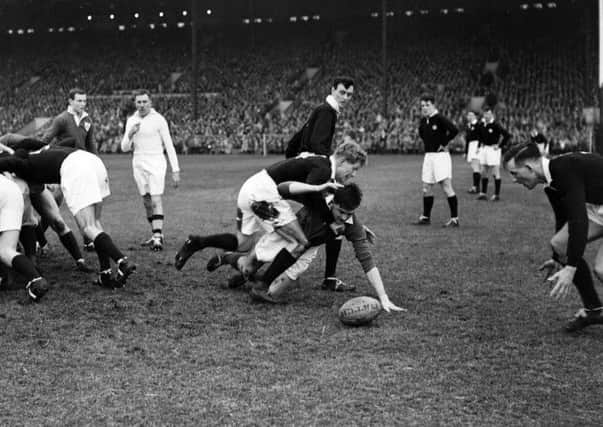Allan Massie: Foot-rush perfect for winter rugby


This is the foot-rush, close and controlled dribbling of the ball by the forwards. It was often effective and hard to stop. It’s certainly a long time since one saw it and I don’t suppose that today’s players ever think of it, let alone practise it.
The foot-rush was different from the hack-and-chase of which on wet days players like Jim Renwick and Mike Gibson were masters – Jim used, I think, to call this “rubbish rugby”, and mighty effective it could – and indeed still can – be. But there was nothing “rubbish” about the foot-rush which required a great deal of skill and hours of practice. As I recall, the last time one saw a Scottish pack regularly employ this tactic was in the late Fifties when forwards like Hugh McLeod, Norman Bruce, Dave Rollo, Hamish Kemp and Jim Greenwood were notable exponents of the art. As a boy at Glenalmond I often saw Greenwood, then the Scottish captain, practise dribbling the ball round the perimeter of a rugby pitch or along the 220 yards cinder track, the ball kept close to the feet as if attached by an invisible string.
Advertisement
Hide AdAdvertisement
Hide AdThe foot-rush was the traditional glory of the Scottish game, giving rise to the cry of “Feet, Scotland, Feet”, which resounded around Murrayfield, and before that, round Inverleith. In his memoirs John M Bannerman, the outstand Scottish forward of the 1920s, recalled how at his club, Glasgow High School FP’s, they practised the foot-rush for hours, interposing the ball between close bunched forwards. The essential thing was to keep just behind the man with the ball at his feet, to avoid being offside, when he slipped the ball sideways.
A well-controlled foot-rush was devilish hard to stop, and required a deal of courage from any one attempting to do so by falling on the ball, for he was likely to get a boot in the back. At a defensive scrum the favoured way to clear was to wheel in order to allow the back-row to take the ball on at their feet. This was why Scotland adhered to the 3-2-3 scrum formation for years after other countries had switched to 3-4-1.
I have never been quite clear why the foot-rush went out of fashion. One reason doubtless was the change in the composition and shape of the ball (more oval, less rounded) which together made handling easier. There was a time after all when props and hookers would rarely have the ball in their hands, lock forwards only at the lineout.
The great South African team that toured here in 1951-2 astonished us by the way in which their forwards handled and passed to each other, something that the French, under the influence of the great Jean Prat, were actually also doing in the years after the 1939-45 war. But we told ourselves that this was possible only because they regularly played in dry conditions. In Scotland where few grounds were well-drained and wet and muddy conditions were common from November through to March, taking the ball on at the feet made better sense.
There was another reason why dribbling went out of fashion, and this was the worst law change ever devised and enacted by the game’s legislators: the removal of the requirement to play the ball with the foot after a tackle. Many of the problems at what we now call the breakdown stem from this law change. The point is that when you had to play the ball with the foot after a tackle, it was regularly taken away from the men on the ground, the tackled player and the tackler.
The game would be improved if the old law was brought back. There would be more variety, and we would be spared the tedious passages of pick-and-drive and one pop pass and into the tackle. The IRB legislators did discuss returning to the old tackle law a few years ago, but I don’t know why they rejected the idea. Certainly some of the very tedious matches in vile conditions which I’ve watched recently might have been more entertaining if the forwards had used their feet rather than their hands.
There was something stirring and invigorating about the old foot-rush, and it would be delightful to hear the old cry of “Feet, Scotland, Feet” echoing around Murrayfield again. In your dreams, as they say. In any case it would require hours of practice for modern players to acquire even half the skill needed to control the ball at their feet to make the foot-rush effective again. Meanwhile coaches would doubtless tell you it is as obsolete as the old idea of shipping the ball along the three-quarter line from a set scrum and giving a wing the chance to run round his opposite number.
SEE ALSO: